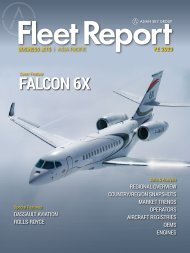Asia-Pacific AAM Report 1H 2023
Create successful ePaper yourself
Turn your PDF publications into a flip-book with our unique Google optimized e-Paper software.
PILOT TRAINING FEATURE<br />
that with the sheer number of eVTOL pilots required, retired airline<br />
pilots would not be able to provide the supply needed. This has<br />
brought up discussions for the need of eVTOL pilot training centers.<br />
These training centers would be either in-house or with Part 61/Part<br />
141 flight schools. Additionally, the cost to train an eVTOL pilot is<br />
incredibly high. A concern has been “who” would pay for this training?<br />
With a Part 135.243 scenario and at least 1,200 hours total flight time<br />
required, training costs could easily reach $100,000.00 USD from zero<br />
time to reaching certification and hour requirements. Adding to this<br />
most, if not all eVTOL concerns (Archer, Joby) have announced that<br />
ultimately their aircraft would operate autonomously. What would<br />
a perspective eVTOL pilot think about having a very finite career in<br />
the eVTOL cockpit? Additionally, another concern, extra space time<br />
accrued as an eVTOL pilot even be useful or credited by the regional,<br />
mainline, and corporate segments of aviation? Many of these<br />
questions remain unanswered.<br />
Simulators<br />
Without question, simulators will serve as an effective tool in the<br />
training/recurrent training of an eVTOL pilot. My recommendation is<br />
that simulator-based training, starting in the home with desktop flight<br />
simulators; XPlane or Microsoft Flight Simulator, be utilized and<br />
available for any perspective eVTOL pilot for familiarity and gauge of<br />
interest prior to flight training. Liberal use of flight simulation during<br />
and after flight training as well as prior to commencing operational<br />
pilot in command duties will prove a great asset. Companies such as<br />
CAE have developed a simulator targeting the eVTOL market tailored<br />
to single-pilot operations. Several other companies are developing<br />
training devices and full-motion flight simulators suitable for training<br />
pilots to operate multiple eVTOL types.<br />
Autonomy<br />
Autonomous flight (AKA no pilots in the cockpit) is generally<br />
considered to be the “end game” for eVTOLs. Eventually, piloted<br />
eVTOL aircraft would be replaced by fully autonomous platforms,<br />
thus eliminating the pilot. This has benefits in terms of cost-savings<br />
(pilot salary) as well as potentially providing a safer passenger<br />
experience. As indicated previously, a major downside to autonomy<br />
is why would a eVTOL pilot desire this path knowing that their career<br />
is finite, and they would be replaced by autonomy? This will certainly<br />
be a challenge for the sourcing, recruitment, and retention of any<br />
eVTOL company utilizing eVTOL pilots.<br />
Final Thoughts<br />
Along with a myriad of regulatory and government requirements<br />
to successfully bring eVTOLs to the marketplace in a commercial<br />
capacity, the requirement and need for eVTOL pilots could become a<br />
critical priority in the coming months as many eVTOL OEMs continue<br />
to target 2024-2025 to commence commercial flight operations.<br />
Knowing that the training time for a new pilot to become a certified<br />
eVTOL pilot can take 18 months or longer.<br />
The time is now for the<br />
FAA and eVTOL OEMs to<br />
coordinate and commence<br />
eVTOL pilot training activities.”<br />
<strong>1H</strong> <strong>2023</strong> ASIA-PACIFIC <strong>AAM</strong> REPORT | 57
















